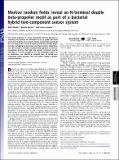Markov random fields reveal an N-terminal double beta-propeller motif as part of a bacterial hybrid two-component sensor system
Author(s)
Berger, Bonnie; Menke, Matthew E.; Cowen, Lenore J.
DownloadMenke-2010-Markov random fields.pdf (306.2Kb)
PUBLISHER_POLICY
Publisher Policy
Article is made available in accordance with the publisher's policy and may be subject to US copyright law. Please refer to the publisher's site for terms of use.
Terms of use
Metadata
Show full item recordAbstract
The recent explosion in newly sequenced bacterial genomes is outpacing the capacity of researchers to try to assign functional annotation to all the new proteins. Hence, computational methods that can help predict structural motifs provide increasingly important clues in helping to determine how these proteins might function. We introduce a Markov Random Field approach tailored for recognizing proteins that fold into mainly β-structural motifs, and apply it to build recognizers for the β-propeller shapes. As an application, we identify a potential class of hybrid two-component sensor proteins, that we predict contain a double-propeller domain.
Date issued
2010-03Department
Massachusetts Institute of Technology. Department of MathematicsJournal
Proceedings of the National Academy of Sciences of the United States of America
Publisher
National Academy of Sciences
Citation
Menke, Matt, Bonnie Berger, and Lenore Cowen. “Markov random fields reveal an N-terminal double beta-propeller motif as part of a bacterial hybrid two-component sensor system.” Proceedings of the National Academy of Sciences 107.9 (2010): 4069 -4074.©2010 by the National Academy of Sciences.
Version: Final published version
ISSN
0027-8424
1091-6490